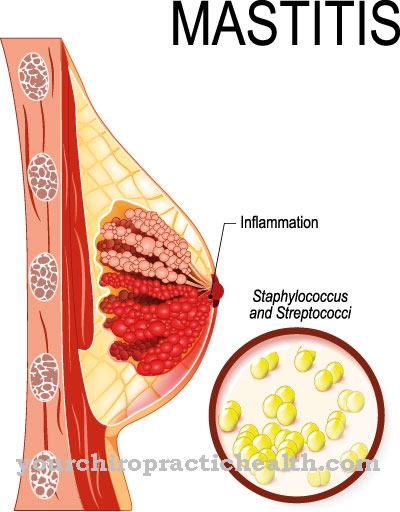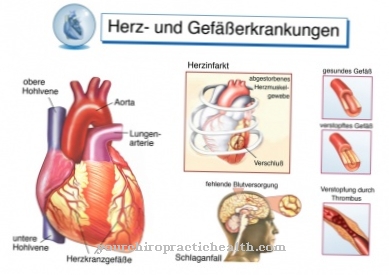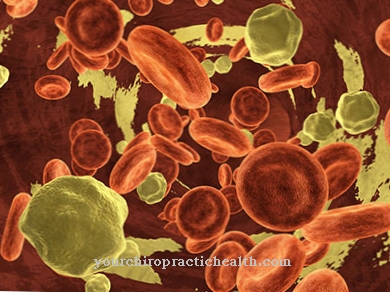At a Umbilical infection or. Omphalitis very young infants can become ill. If left untreated, the infection can be life-threatening, so antibiotic therapy and hospital observation are almost always necessary. In countries with adequate hygiene standards and good medical care, umbilical infections no longer contribute to infant mortality.
What is a navel infection?
.jpg)
© Alena Ozerova - stock.adobe.com
The Umbilical infection or Omphalitis In newborn infants, bacterial inflammation of the umbilical stump that remains after the umbilical cord has been cut and the surrounding tissue of the abdominal wall.
Mixed infections with different types of bacteria that are part of the normal human bacterial flora are often responsible for complications in umbilical healing. Frequently involved in umbilical infections are the skin species Staphylococcus aureus and streptococcus and the intestinal bacteria Escherichia coli, Klebsiella pneumoniae and Proteus mirabilis.
causes
Since the umbilical stump is still an open wound for a few weeks after delivery, germs can penetrate relatively easily and possibly trigger an umbilical infection. The germs usually come from the mother and reach the navel during delivery or in the following days.
The infant's immature immune system is often unable to cope with the normally harmless bacteria. When it comes to bacteria, a newborn is virtually a blank slate - in the largely sterile environment of the uterus, its body has hardly had any experience with bacteria. Risk factors for a Umbilical inflammation are a low birth weight, other infectious diseases such as pneumonia or pre-existing sepsis, immune deficiency and poor general condition.
In normal-weight, healthy infants, unusually long births and previous complications such as placental infections are risk factors. An umbilical cord catheter inserted during neonatal treatment also increases the risk of developing an umbilical infection.
Symptoms, ailments & signs
An umbilical infection usually occurs immediately after birth. The disease can be recognized by the smeary, purulent, usually reddened navel, which is very sensitive to touch. The infection can also cause general symptoms such as fever, fatigue and malaise. Affected children also drink little and usually refuse to eat.
There may be bleeding and swelling around the navel. As the infection progresses, the navel bulges forward and turns reddish-white in color. If pus forms, a cyst will also develop. This can break open and lead to the spread of the pathogens into the blood, which can result in complications such as superinfections and sepsis.
Possible consequences of a navel infection are also peritonitis, abscesses in the gastrointestinal tract and bacterial thrombosis. In severe cases, liver abscesses or inflammation of the inner lining of the heart develop. Omphalitis is a life-threatening condition and, if left untreated, can lead to infant death.
Symptoms develop in the first hours to days after birth and quickly increase in intensity. If treatment is given before an abscess has formed, the symptoms will usually clear up quickly.
Diagnosis & course
Even if slight redness and bleeding can be normal side effects of umbilical healing: signs of a Umbilical infection should always be assessed by the pediatrician. The diagnosis of umbilical infection is made by examining the umbilicus.
Reddening of the skin, bloody or purulent discharge, swelling, warmth, and bulging of the navel are common symptoms of an incipient umbilical infection. In the advanced stages of umbilical inflammation, extreme bulging of the umbilicus can often be observed. Fever, increased heartbeat, low blood pressure and apathy occur.
If left untreated, the infection can quickly pass into the blood and lead to sepsis and life-threatening bacterial infections of the organs. Peritonitis, liver abscesses, bacterial thromboses (vein occlusions) and endocarditis (inflammation of the inner lining of the heart) can be extremely dangerous consequences of an umbilical infection.
Complications
The umbilical infection is a life-threatening disease. For this reason, treatment must be given in any case, as there is usually no self-healing. In the worst case, the baby can die from the umbilical infection. However, if the hygiene standards are observed, death can be avoided.
Those affected usually experience severe reddening or swelling of the belly button. A secretion can also emerge from the navel. The infection continues to spread around the body, usually leading to a fever and an increased heart rate. The umbilical infection can also cause low blood pressure and breathing difficulties. Furthermore, without treatment, damage to the liver and peritonitis can occur.
Those affected can also develop heart inflammation and die from it. In most cases, relatives and parents also suffer from psychological distress or from depression. The treatment of the umbilical infection is usually done with the help of antibiotics and leads to success relatively quickly. There are no complications.
When should you go to the doctor?
Babies are at risk of developing a navel infection. Therefore, parents or legal guardians in particular should initiate a doctor's visit with their offspring if complaints or irregularities occur. If the newborn baby behaves in a strange or conspicuous manner, a doctor is recommended. Weepiness, apathy, or indifference are signs of an existing disagreement. If food is refused, body temperature rises or restlessness occurs, the infant needs medical help.
Consultation with a doctor is required in the event of sleep disorders, visual changes in the area of the navel, bleeding or swelling. Reddening of the skin around the navel or open wounds require medical treatment. If the symptoms increase in scope or intensity, you should see a doctor as soon as possible. In severe cases, there is a risk of sepsis and thus a life-threatening condition for the child.
In poor hygienic conditions, the infant may die prematurely without medical treatment. Persistent fatigue and malaise in the infant should be reported to a doctor. If the child hardly reacts to social interactions or other sensory stimuli from the environment, these are signs of an existing irregularity. The observations should be discussed with a doctor so that the cause can be clarified and a treatment plan can be established to alleviate the symptoms.
Treatment & Therapy
Is the Umbilical infection in the very early stages, local disinfecting measures can bring the inflammation to a standstill. Typically, however, a hospital stay of around two weeks is necessary for an umbilical infection. A combination of antibiotics that fight the different types of bacteria involved is given intravenously.
Penicillin is often supplemented by aminoglycosides and agents that are effective against anaerobic germs. The continuous monitoring of vital functions, which is possible in the hospital, enables the course of the infection to be observed precisely. Any complications are recognized early and treated in good time.
In addition to antibiotic therapy, measures to stabilize blood pressure, ventilation and other steps to stabilize the general condition are often required. Possible complications of an umbilical infection also include abscesses (encapsulated foci of pus) or the death of skin and muscle tissue (necrosis) around the umbilicus. In these cases, surgical interventions to remove foci and necrotic tissue are urgently needed.
Outlook & forecast
The prognosis for an umbilical infection is very favorable.However, complications of inflammation, if left untreated, result in death rates of 7% to 15%. The dreaded sepsis often occurs in around 4% of newborns who develop a localized form of omphalitis. The death rate in such cases is still very high despite the advances in modern medicine today. In the case of sepsis, the mortality rate is 30% to 40% in children born normally, whereas the death rate in premature babies is around 50% and more. This prognosis indicates the very high need for a timely diagnosis of the disease. Omphalitis is a pathology that can be easily seen despite the rapid prevalence of inflammation. It should therefore be possible to diagnose it even by the mothers of the affected children on the basis of the visual assessment of the navel.
The unforeseen diagnosis of the disease and the resulting delayed treatment of omphalitis often lead to disability or even death of affected children. Therefore, timely diagnosis and effective treatment are very important. Consequences and complications occur when the bacteria migrate to the umbilical cord, which is a direct access to the blood flow. Complications develop that significantly increase the risk of death.
prevention
Umbilical hygiene measures can prevent a Umbilical infection be effective. However, today the navel is generally dealt with much more relaxed than in previous generations. For example, it is generally no longer recommended to cover or bandage the navel, and bathing is no longer advised.
Silver powder or disinfectants are no longer part of normal navel care. It is important to keep the navel dry, airy, clean and free of urine and bowel movements. The umbilical stump should only be touched with washed hands. If it is necessary to clean the navel directly, sterile compresses moistened with water or alcohol are recommended.
Aftercare
As long as the navel infection has not completely healed, the diaper should be closed a little below the navel in babies. Otherwise there is a risk of the navel becoming infected again through excretions. Adults affected should also wear their clothes as loosely as possible.
Because covering it would significantly delay the drying out and healing of the navel. If the belly button gets wet, those affected should use some umbilical powder and thus keep the inflamed navel as dry as possible. A special antibiotic umbilical powder can also be used. Breathable umbilical compresses are also available to keep the umbilicus dry.
The most important thing in follow-up care is that the navel stays dry and, above all, is protected from chafing. Under no circumstances should creams or perfumed oils be used for follow-up navel care, as they would only irritate and soften the sensitive skin. If those affected use a special powder to dry out more quickly, all powder residues should be carefully removed from the inflamed navel once a day.
The best way to do this is with the help of a sterile compress that has previously been soaked in diluted calendula essence. Any scabs should not be removed, otherwise there is a possibility of injuring the sensitive navel. If redness, wetness or even suppuration persists despite careful follow-up care, you are advised to consult a doctor.
You can do that yourself
If an umbilical infection is detected, parents should first exercise strict personal hygiene in the child to prevent further spread of the inflammation. The doctor can prescribe a suitable ointment that the parents can apply to the affected areas.
In addition, close medical supervision is important. Parents should consult their doctor closely and inform them of any complications. If the inflammation gets worse or if there are additional symptoms, for example fever or increasing malaise, it is best to go to your doctor's office immediately. The other self-help measures concentrate on using the antibiotic and antiseptic ointments according to the doctor's instructions. In addition, care should be taken to ensure that the child is drinking enough fluids. If this is taken into account, a speedy recovery can be expected.
Nevertheless, serious complications such as necrosis can develop in individual cases. Then the child has to be treated surgically. After such an operation, it is important to be careful and to stay warm. In addition, the child should be examined for allergies so that there are no unforeseen complications when using pain relievers and anti-inflammatory drugs.

.jpg)





















.jpg)



